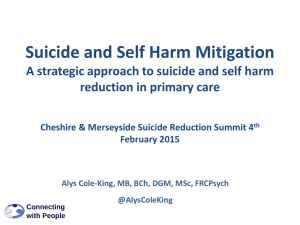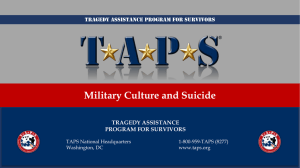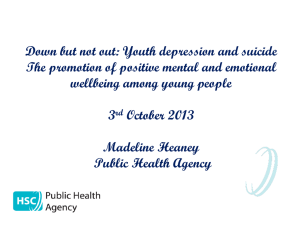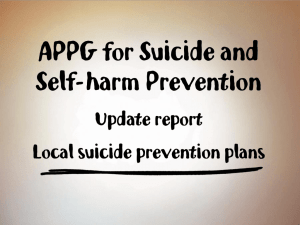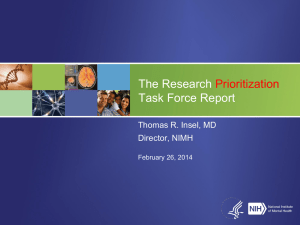Suicide Prevention – Focus on Adults
advertisement
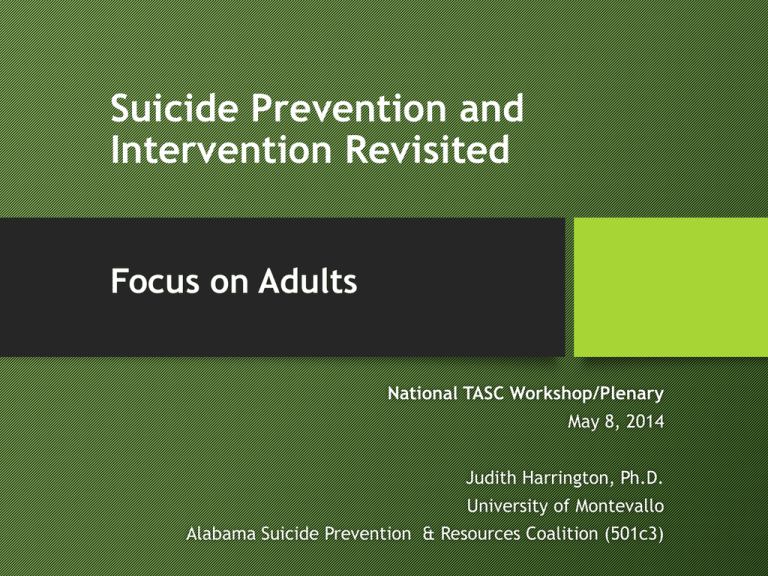
Suicide Prevention and Intervention Revisited Focus on Adults National TASC Workshop/Plenary May 8, 2014 Judith Harrington, Ph.D. University of Montevallo Alabama Suicide Prevention & Resources Coalition (501c3) Nationally, 38,364 persons died from suicide, now the 10th cause of death (AAS, 2010). • Alabama Suicide Prevention and Resources Coalition (ASPARC) A 501c3 Non-Profit Agency • This presentation is partly funded by a Garrett Lee Smith Suicide Prevention grant from SAMHSA in partnership with the Alabama Department of Public Health and the ASPARC, your tax dollars brought home to prevent suicide. PREFERRED TERMS • Died from suicide • Completed suicide • AVOID: committed suicide, took his own life, chose to end her life, “successful suicide” (no such thing as a successful suicide, only successful prevention) • Survivor of suicide loss • Attempt survivor, the lived experience Definitions - suicide • Death by suicide, (died by suicide) or completed suicide: Death from self-inflicted injury, poisoning, or suffocation where there is evidence that the act was intentional (purposed, aim, or goal)and led to death • Suicide intent: Self-injurious behavior with non-fatal outcome, with evidence of intent to die (was rescued, thwarted, or changed mind). • Suicide ideation: Thoughts of suicide related behavior, do not make an explicit attempt • Suicide attempt survivors • Suicide survivors (of loss) (often confused with attempt survivors) Examples of suicidal behavior Suicide ideation Suicide rehearsal Suicide “gesture” Suicide attempt Completed suicide or death from suicide Days of limited survival from attempt before death • Permanent disability from suicide attempt • • • • • • Incidence of Suicide From a 2008 CDC Study • 2.9 million in U.S. ages 18-29 had suicidal thoughts • 2.2 million in U.S. considered adults in U.S. had suicide plans • 1.0 million adults in U.S. made a suicide attempt in the 2007 • Source: Crosby, A. E., Han, B., Ortega, L. A. G. Parks, S. E., Gfroerer, J. (2011). Suicidal thoughts and behaviors among adults aged ≥ 18 years---United States 2008-2009. Retrieved http://www.cdc.gov AT RISK GROUPS BASED ON INTENT TO DIE AND SURVIVAL Campbell (2005) Survival: Die Intent: Die Intent: Live Survival: Live SUICIDE “died by suicide” [formerly “completed” suicide or chose to end life] SUICIDE ATTEMPT Ambivalence is present and help reaches them. Intervention is successful. ACCIDENTAL SUICIDE An attempt gone awry. PARASUICIDE So-called "attentionseeking" or "cry for help" (euphemisms) 40 times more likely to die by suicide. FALSE POSITIVE AND FALSE NEGATIVE SUICIDE ASSESSMENT Adapted from Granello & Granello (2007) Counselor assesses that client IS suicidal Counselor assesses that client IS NOT suicidal Client IS suicidal Client IS NOT suicidal Accurate Assessment False positive False negative Accurate Assessment COUNSELOR LIABILITY Harrington (2008) Client lives Counselor is effective Counselor is ineffective Assessment, intervention works. Client Dies "The operation was a success but the patient died." Luck. Something else prevails, other resources, hardiness not Potential malpractice. attributable to Scope of competence counselor. issues. Is suicide a choice? Andrew Slaby, M.D., Ph.D., M.P.H., New York University and New York Medical College: • People who die by suicide do not want to die; they simply want to end the pain often caused by depression. If there were another way to end the pain, they would seek it. Failing to find a source of reprieve, they become hopeless. More than depression, hopelessness predicts who will die by suicide… (p. 11). Is suicide a choice? Mark J. Goldblatt, M.D., Harvard University Department of Psychiatry, in Case Discussion: …that his [the case under discussion] cognitive function was impaired by his physical illnesses or by his depression…he was never really competent to make his own treatment decisions, because he was impaired by his mental illness (p. 336). Is suicide a choice? Kay Redfield Jamison, Johns Hopkins University, author of, An Unquiet Mind and Night Falls Fast, has bipolar disorder and attempted suicide, stated • In short, when people are suicidal, their thinking is paralyzed, their options appear spare or nonexistent, their mood is despairing, and hopelessness permeates their entire mental domain. The future cannot be separated from the present, and the present is painful beyond solace. (p. 93). OLD VS. NEW PARADIGM FOR UNDERSTANDING SUICIDE OLD • a. Suicide: Killing of oneself • b. Goal: End life • c. It is seen as an event or a behavior. • d. Viewed as a decision and a personal choice. • e. Viewed as a means of control or manipulation. NEW • a. Penacide: Killing the pain. • b. Goal: End pain and suffering. • c. It is seen as a process of debilitation. • d. Viewed as a disease outcome; no choice involved beyond crisis point in the process of debilitation. • e. Viewed as the result of severe stress and psychological pain. OLD VS. NEW PARADIGM FOR UNDERSTANDING SUICIDE OLD NEW • f. Seen as a voluntary action and individual responsibility. • g. The individual is seen as a decision-maker. • h. Thought to be a phenomenon involving the mind. • i. Etiology: Emotional disorder, personality disorder, poor coping skills • f. Seen as an involuntary response. • g. The individual is seen as a victim. • h. Thought to be a physiological or neurobiological phenomenon involving the brain. • i. Etiology: A biochemical deficiency created or aggravated by pain. CORE COMPETENCIES FOR ASSESSING & MANAGING SUICIDE RISK A. Working with Individuals at Risk for Suicide: Attitudes and Approach 1. Manage one’s own reactions to suicide 2. Reconcile the difference (and potential conflict) between the clinician’s goal to prevent suicide and the client’s goal to eliminate psychological pain via suicidal behavior 3. Maintain a collaborative, non-adversarial stance 4. Make a realistic assessment of one’s ability and time to assess and care for a suicidal client as well as for what role one is best suited CORE COMPETENCIES FOR ASSESSING & MANAGING SUICIDE RISK B. Understanding Suicide • 5. Define basic terms related to suicidality • 6. Be familiar with suicide-related statistics • 7. Describe the phenomenology of suicide • 8. Demonstrate understanding of risk and protective factors CORE COMPETENCIES FOR ASSESSING & MANAGING SUICIDE RISK C. Collecting Accurate Assessment Information 9. Integrate a risk assessment for suicidality early in a clinical interview, regardless of the setting in which the interview occurs and continue to collect assessment information on an ongoing basis 10. Elicit risk and protective factors 11. Elicit suicide ideation, behavior, and plans 12. Elicit warning signs of imminent risk of suicide 13. Obtain records and information from collateral sources as appropriate CORE COMPETENCIES FOR ASSESSING & MANAGING SUICIDE RISK D. Formulating Risk 14. Make a clinical judgment of the risk that a client will attempt or complete suicide in the short and long term 15. Write the judgment and the rationale in the client’s record 16. Collaboratively develop an emergency plan that assures safety and conveys the message that the client’s safety is not negotiable 17. Develop a written treatment and services plan that addresses the client’s immediate, acute, and continuing suicide ideation and risk for suicide behavior 18. Coordinate and work collaboratively with other treatment and service providers in an inter-disciplinary team approach CORE COMPETENCIES FOR ASSESSING & MANAGING SUICIDE RISK E. Developing a Treatment and Services Plan 16. Collaboratively develop an emergency plan that assures safety and conveys the message that the client’s safety is not negotiable 17. Develop a written treatment and services plan that addresses the client’s immediate, acute, and continuing suicide ideation and risk for suicide behavior 18. Coordinate and work collaboratively with other treatment and service providers in an inter-disciplinary team approach CORE COMPETENCIES FOR ASSESSING & MANAGING SUICIDE RISK F. Managing Care 19. Develop policies and procedures for following clients closely including taking reasonable steps to be proactive • Motivate and support clients in getting them to a referral source or to their next treatment/intervention session • Engage in collaborative problem-solving with the client to address barriers in adhering to the plan and to revise the plan as necessary…session by session • Assure that the client, family, significant others, and other care providers are following through on actions as agreed • Assess the outcome of each referral • Develop and implement follow-up procedures for all missed appointments • Be available between appointments • Arrange for clinical coverage when therapist is unavailable • Assure continuity of care and follow-up contact with all suicidal clients who have ended treatment 20. Follow principles of crisis management CORE COMPETENCIES FOR ASSESSING & MANAGING SUICIDE RISK G. Documenting 21. Document the following items related to suicidality • • • • • • • Informed consent Information that was collected from a bio-psycho-social perspective Formulation of risk and rationale Treatment and services plan Management Interaction with professional colleagues Progress and outcomes CORE COMPETENCIES FOR ASSESSING & MANAGING SUICIDE RISK H. Understanding legal and regulatory issues related to suicidality 22. Understand state laws pertaining to suicide 23. Understand that poor or incomplete documentation make it difficult to defend against legal challenges 24. Protect client records and rights to privacy and confidentiality following the Health Insurance Portability and Accountability Act of 1996 that went into effect April 15, 2003 Continuum of Suicide Risk Think of risk as a status on a continuum Doing well Life stress Existential reflection Crisis, Pile up High Emergency Risk Harm in 24 hrs +/- Build up over weeks, months Recent loss/distress Chronic Intent Demographic markers more important Lethal Means Plan Rehearsals Warning Signs Relationship problems Marilyn Monroe type suicide Vince Foster type suicide Assessment of suicidal risk • IS PATH WARM • • • • • • • • • Ideation Substance abuse Purposelessness Anxiety Trapped Hopelessness Withdrawal Recklessness Mood Change There are a plethora of paper & pencil, authenticated instruments to assess suicide, such as the PANSI and many more. • SIMPLE STEPS • • • • • • • • • Suicidal Ideation Means to complete Perturbation Loss Earlier attempts Substance use Trouble-solving ability Emotion • Hopelessness, worthlessness, depression • Parent, family history • Stress and life events Assessment of suicidal risk • F.A.C.T. • Feelings: Hopelessness, Fear of loss of control, helplessness, sadness • Actions or events: • Loss, agitation, Sub Abuse, reckless • Change in personality, behavior, sleep, etc. • Threats • Statements, plans gestures • Acute vs. Chronic • Emergent vs. long term • Warning signs vs. risk factors • Event vs. relational Distinguishing risk from warning • Demographics or Risk Factors • Chronic • Over many weeks, months, years • “marker” for suicide, not a predictor • Prior attempts • Hx of abuse • Poor support syst. • Warning Signs • recent loss or defeat • Changes in mood, actions, ADL’s • Hopeless • Intent, plan, means, timetable • rehearsals • Substance abuse Chronic vs. Acute Risk • Chronic • Ongoing suicidality due to past hx and the presence of certain risk factors (alcohol or Axis II), • has no current suicidal intent, no organized plan, • has reasons for living • Not considered immediate risk, but under certain conditions (recurrence of depression, actual or anticipated relationship loss, financial setbacks, legal problems, or serious medical dx…could develop into acute risk Chronic vs. Acute Risk • Acute • Serious recent suicidal behavior, current psychotic processes, and/or serious suicidal planning or intent. Can be considered at nearterm risk for suicide within hours, days, or weeks from the time of assessment. • Paramount for MHP to intervene immediately Low, Moderate, High risk • Low: no hx of past suicidal behavior, no current suicidal ideation, some chronic risk and anticipated losses, and protective factors are present • Moderate: elevated level of risk based on factors such as suicidal ideation or desire, chronic drug or alcohol use, problematic relationships or some other current stressor. • High: hx of multiple suicide attempts, the presence of recent suicidal ideation and planning, and an anticipated triggering event “Purpose” of suicide • To end the pain • To stop being a burden or disappointment to family • To overcome psychache • To overcome shame or dishonor • To escape feeling trapped • To go be with loved ones (or friend or significant other) in heaven • Other….? Essential Features of Risk Assessment • • • • • • • Each person is unique It is complex and challenging It is an ongoing process It uses multiple perspectives Tries to uncover foreseeable risk Relies on clinical judgment Assessment is considered to be “treatment” Coping skills for suicidal risk • Safety planning in concert with a clinician • • • • • • • • • • Means restriction Soothing Self-care Family support Crisis planning Community resources Life skills, problem-solving Social support Cognitive behavioral approach See Rudd (2006) Good Resources • Rudd, M. D. (2006). The assessment and management of suicidality (practitioner's resource). Sarasota, FL: The Professional Resource Exchange. • American Association of Suicidology www.suicidology.org • American Foundation for Suicide Prevention www.afsp.org • SAMHSA TIP 50 Addressing Suicidality in Substance Abuse Treatment Settings www.samhsa.gov • National Suicide Prevention Lifeline (NSPL): •1-800-273-TALK (8255) • National Suicide Prevention Lifeline (NSPL) •1-800-SUICIDE Thank you for attending! Comments, questions, Thoughts, or feelings? Judith Harrington harringtonjudith@bellsouth.net About your presenter • Facilitator of the Birmingham Crisis Center Suicide Survivors support group for 14 years • 5 year Member of the National Suicide Prevention Lifeline Training, Standards and Practices Committee • Approved Trainer for the American Association of Suicidology and the Suicide Prevention Resource Center • President, 2010-2013, two terms, Alabama Suicide Prevention & Resource Coalition (ASPARC) • Former Coordinator of the Alabama Suicide Prevention Task Force (20072008), member since 2004 • Professor, developed Suicide Prevention, Intervention, & Postvention courses, 3 credit hour graduate Counseling Class, UAB, University of Montevallo suicidology course • Full time faculty member, University of Montevallo Counselor Education and part time private practice after 27 years in full time practice.





